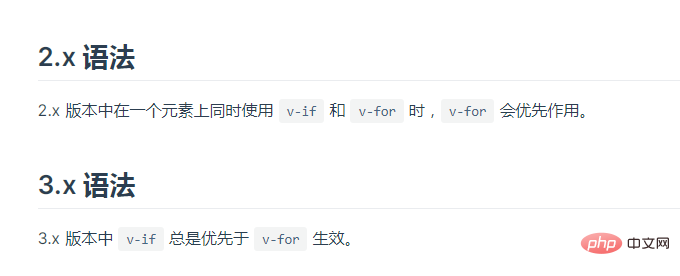Home > Article > Web Front-end > Which one has higher priority, v-if or v-for in vue?
In vue2, v-for has a higher priority than v-if; in vue3, v-if has a higher priority than v-for. In Vue, never use v-if and v-for on the same element at the same time, which will cause a waste of performance (each rendering will loop first and then perform conditional judgment); if you want to avoid this situation, Templates can be nested in the outer layer (page rendering does not generate DOM nodes), v-if judgment is performed at this layer, and then v-for loop is performed internally.

The operating environment of this tutorial: windows7 system, vue3 version, DELL G3 computer. The
v-if directive is used to conditionally render a piece of content. Directives are used to conditionally render a block of content. This content will only be rendered if the directive's expression returns true. The v-for directive renders a list based on an array. The v-for directive requires special syntax in the form of item in items, where items is the source data array or object, and item is Is an alias for the array element being iterated.
When v-for, it is recommended to set the key value and ensure that each key value is unique, this is diffAlgorithm optimization.
<modal></modal>
Priority
In fact, the answers in vue2 and vue3 are completely opposite.
In vue2, v-for has a higher priority than v-if
In vue3, v-if has a higher priority In v-for

## v-for and v-if
in vue2 v-if and v-for are both directives in the vue template system.
vue template is compiled, the command system will be converted into an executable render function.
p tag and use v-if and v-for
<div>
<p>
{{ item.title }}
</p>
</div> to create vue Example, store isShow and items data.
const app = new Vue({
el: "#app",
data() {
return {
items: [
{ title: "foo" },
{ title: "baz" }]
}
},
computed: {
isShow() {
return this.items && this.items.length > 0
}
}
})
ƒ anonymous() {
with (this) { return
_c('div', { attrs: { "id": "app" } },
_l((items), function (item)
{ return (isShow) ? _c('p', [_v("\n" + _s(item.title) + "\n")]) : _e() }), 0) }
}
_l is the list rendering function of vue, and a if judgment will be made inside the function. Preliminary conclusion:
v-for has a higher priority than v-if. Then put
v-for and v-if in different labels
<div>
<template>
<p>{{item.title}}</p>
</template>
</div> and then output the render function
ƒ anonymous() {
with(this){return
_c('div',{attrs:{"id":"app"}},
[(isShow)?[_v("\n"),
_l((items),function(item){return _c('p',[_v(_s(item.title))])})]:_e()],2)}
} At this time we can see that when v-for and v-if act on different tags, they are judged first and then the list is rendered.
export function genElement (el: ASTElement, state: CodegenState): string {
if (el.parent) {
el.pre = el.pre || el.parent.pre
}
if (el.staticRoot && !el.staticProcessed) {
return genStatic(el, state)
} else if (el.once && !el.onceProcessed) {
return genOnce(el, state)
} else if (el.for && !el.forProcessed) {
return genFor(el, state)
} else if (el.if && !el.ifProcessed) {
return genIf(el, state)
} else if (el.tag === 'template' && !el.slotTarget && !state.pre) {
return genChildren(el, state) || 'void 0'
} else if (el.tag === 'slot') {
return genSlot(el, state)
} else {
// component or element
...
}When making if judgment, v-for is judged before v-if.
v-for has a higher priority than v-if.
v-for and v-if in vue3
In vue3, v-if has a higher priority than v-fo, so when v-if is executed , the variable it calls does not exist yet, it will cause an exceptionExplanation: There are usually two situations that cause us to do this:
1. In order to filter the list Projects, such as:v-for="user in users" v-if="user.isActive"
activeUsers) and let it return the filtered list (such as users.filter(u=>u.isActive)).
v-for="user in users" v-if="shouldShowUsers"
v-if to the container element (such as ul, ol) or wrap a layer of template on the outside.
Note
Never use v-if and v-for on the same element at the same time, which will cause a waste of performance (Each rendering will loop first and then perform conditional judgment)<template v-if="isShow">
<p v-for="item in items">
</template>
computed: {
items: function() {
return this.list.filter(function (item) {
return item.isShow
})
}
}The above is the detailed content of Which one has higher priority, v-if or v-for in vue?. For more information, please follow other related articles on the PHP Chinese website!